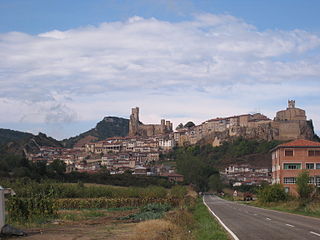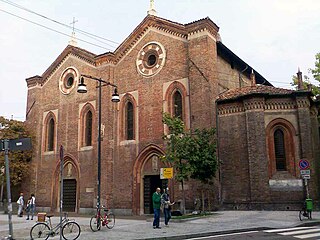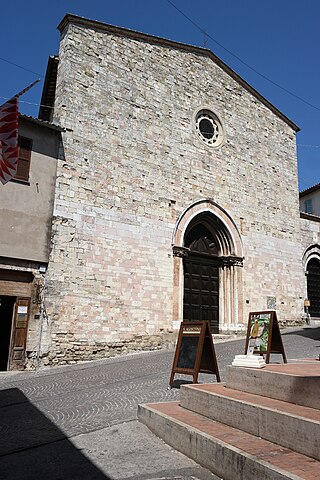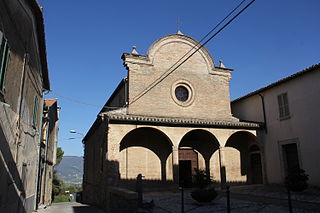
Todi is a town and comune (municipality) of the province of Perugia in central Italy. It is perched on a tall two-crested hill overlooking the east bank of the river Tiber, commanding distant views in every direction. It was founded in antiquity by the Umbri, at the border with Etruria; the gens Ulpia of Roman emperor Trajan came from Todi.

Atessa is an municipality in the province of Chieti, Abruzzo, south-eastern Italy. It is part of the Val di Sangro mountain community. It is the largest municipality in the province by extension and eighth by population.

Saint Praxedes, called "a Roman maiden", was a saint and virgin who lived in the Roman Empire during the 2nd century. Along with her sister, Saint Pudentiana, she provided for the poor and gave care and comfort to persecuted Christians and martyrs. Her veneration began in the 4th century and many churches have been dedicated to her.

Portuguese Gothic architecture is the architectural style prevalent in Portugal in the Late Middle Ages. As in other parts of Europe, Gothic style slowly replaced Romanesque architecture in the period between the late 12th and the 13th century. Between the late 15th and early 16th century, Gothic was replaced by Renaissance architecture through an intermediate style called Manueline.

Frías is a town located in the northern part of the province of Burgos, in Castile and León, Spain. In 2010 it had a population of only 275 inhabitants.

Santa Maria della Consolazione is a Renaissance-style pilgrimage church in Todi, Italy. The centralized, symmetric plan, surmounted by a tall dome, distinguishes this Renaissance church, from the more common elongated basilica or Latin-cross designs. Another Todi sanctuary church, also with a symmetric layout, is the Tempio del Santissimo Crocifisso on the eastern end of town.

Santa Maria Incoronata is a church in Milan, Italy, completed in 1460.

The Santa Monica Parish Church, commonly known as the Minalin Church, is a Baroque Roman Catholic church, located in poblacion area of San Nicolas in Minalin, Pampanga, Philippines. The church, built during the Spanish era, was declared a National Cultural Treasure by the National Commission for Culture and the Arts and the National Museum of the Philippines on August 27, 2011, one of 37 churches in the country bestowed that honor.

Sant'Elena, also sometimes called Santa Lena, is a Gothic-style, Roman Catholic church at the extreme east end of the sestiere of Castello in the City of Venice, Italy.

The Convento de Santa Dorotea is an Augustinian nun's convent in Burgos, Castile and León, Spain. It is a Gothic construction, and dates back to 1387, when Dorotea Rodriguez Valderrama, along with other devout women formed a nun's community at the old church of Santa Maria la Blanca. The community adopted the rule of St. Augustine in 1429 with the support of Bishop Pablo de Santamaría. In 1457 they moved to the church of San Andrés, until in 1470 they settled in the current location in the barrio of San Pedro y San Felices. Among the many benefactors who favored the monastery was King John II of Castile. Tombs of note include those of Alonso de Ortega, and Bishop Juan de Ortega, the work of Nicholas de Vergara, 1516.

Todi Cathedral is a mainly Gothic-style Roman Catholic cathedral in Todi, Umbria, Italy, dedicated to the Annunciation of the Virgin Mary. It was formerly the seat of the bishops of Todi, and since 1986 has been a co-cathedral of the diocese of Orvieto-Todi.

Palazzo del Popolo, also called Palazzo del Priori or Podesta, is a Gothic architecture civic palace in Todi, region of Umbria, Italy.

Sant'Agostino is a Gothic-style, Roman Catholic church in Montalcino, region of Tuscany, Italy.

Santa Maria in Camuccia is a Romanesque and Gothic-style, Roman Catholic church on Via Santa Maria in Camuccia number 54, in the center of Todi, province of Perugia, region of Umbria, Italy.

San Carlo, formerly Sant'Ilario is a small Romanesque and Gothic-style, Roman Catholic church on Viale San Carlo and intersection with Via Cesia and della Piana, below the Piazza del Mercato Vecchio, in the center of Todi, province of Perugia, region of Umbria, Italy.
San Pietro is a Gothic-style, Roman Catholic church in the center of the town of Leonessa, province of Rieti, region of Lazio, central Italy.

San Filippo Benizzi, formerly Santa Maria delle Grazie is a Roman Catholic sanctuary church and convent on Via Giacomo Matteoti, just inside the Porta Romana and across the Street from San Niccolo, in the center of Todi, province of Perugia, region of Umbria, Italy.
The Casa Dipinta of Todi is a painted former vacation home of the artist Brian O'Doherty and his wife Barbara Novak located at Via delle Mura Antiche #25 at the intersection with Via Santa Prassede, in the historic center Todi, region of Umbria, Italy.

Sant'Agostino is a gothic-style, Roman Catholic church located on Corso Goffredo Mameli #28 in the historic center of Montefalco, in the Province of Perugia, region of Umbria, Italy.

Sant'Illuminata is a Renaissance-style, Roman Catholic church located at the corner of Via Santa Chiara and Via Severini just south of the historic center of Montefalco, in the Province of Perugia, region of Umbria, Italy. The church, originally founded alongside a female monastery, was dedicated to Illuminata of Todi, putatively a martyred saint from the 4th century who lived in a hermitage between Massa Martana and Todi, and gained veneration in this region of Umbria. The church is noted for its early 16th-century frescoes by Francesco Melanzio and others.


















